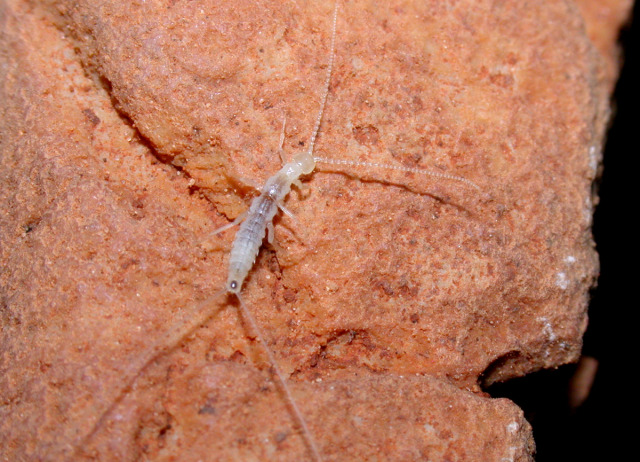Two new dipluran species unearthed from subterranean habitats of the Canary Islands
Heriberto López, a researcher from the IPNA's Ecology and Evolution in the Islands group, has participated in an investigation in which two new species of diplura have been located in the underground environment of the Canary Islands. Alberto Sendra (University of Alcalá de Henares), one of the most important specialists in the world, Pedro Oromí (University of La Laguna), entomologist and reference specialist in the underground fauna of the Canary Islands, and the entomologist of the University of Valencia, Jesús Selfa, have also participated in the work.
The paper "Two new dipluran species unearthed from subterranean habitats of the Canary Islands" published by the journal Subterranean Biology points out that these two new dipluran species of the family Campodeidae have been discovered in the Canary Islands. The new species Remycampa herbanica was located in the Cueva de Montaña Blanca, a volcanic tube in Fuerteventura whose integrity and conservation is threatened by being located within a duplex development under construction. This species is related to Remycampa launeyi, another diplure that inhabits the soils of northwest Africa and can also be found on the islands of Tenerife, Gran Canaria, El Hierro and Lanzarote. However, the new cave species is clearly different from Remycampa launeyi because of its accentuated adaptation to the underground environment, presenting the body and appendages (legs, antennae and fences) more elongated than normal. In addition, the authors have discovered that this new species has a greater number of olfactory chemoreceptors, which have turned out to have a form never before observed in the family of Campodidae. In an attempt to identify its closest relatives, the COI barcode region of Remycampa herbanica was sequenced. However, the reference sequences available so far were found to be of species too far removed to be able to establish a well-supported kinship.
The other described species, Spaniocampa relicta, was discovered in the subsoil of an area of the Brezal del Palmital, in Gran Canaria. It was assigned to a genus of which only one other species was known in the world until now, Spaniocampa prima, which inhabits the soil of the Republic of Guinea. Both species are clearly differentiated by the number of macrosetae (upright hairs) on their abdomens. In addition, female Spaniocampa relicta have small macrosetae arranged in groups on the ventral side of the first segment of the abdomen. These groups of macrosetae form structures of unknown function, until now never described in other Campodidae species.
The different dipluran species present in the Canary Islands have always been captured in the soil and subsoil of the islands, but Remycampa herbanica is the first species to be found in volcanic tubes in the archipelago. These two new discoveries bring to six the number of species of campodeid present in the Canary Islands. Of all of them, Remycampa herbanica and Spaniocampa relicta are the only ones endemic to the Canary Islands, while one of the others is a non-endemic native (the aforementioned Remycampa launeyi) and the other three (Campodea fragilis, Campodea devoniensis and Podocampa ceballosi) are considered to have been introduced to the archipelago.
The studies being carried out over the last decade in the underground environment of the Canary Islands have led to the discovery of new species for the biodiversity of the islands, which indicates that it is an unexplored habitat full of possibilities for science.
